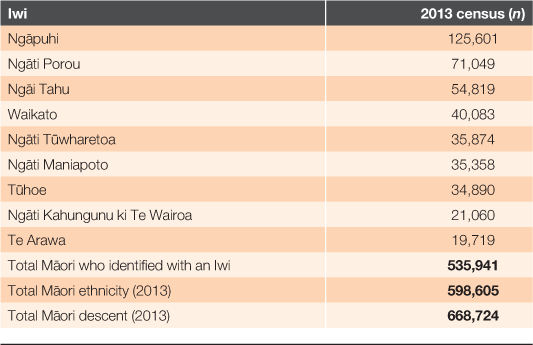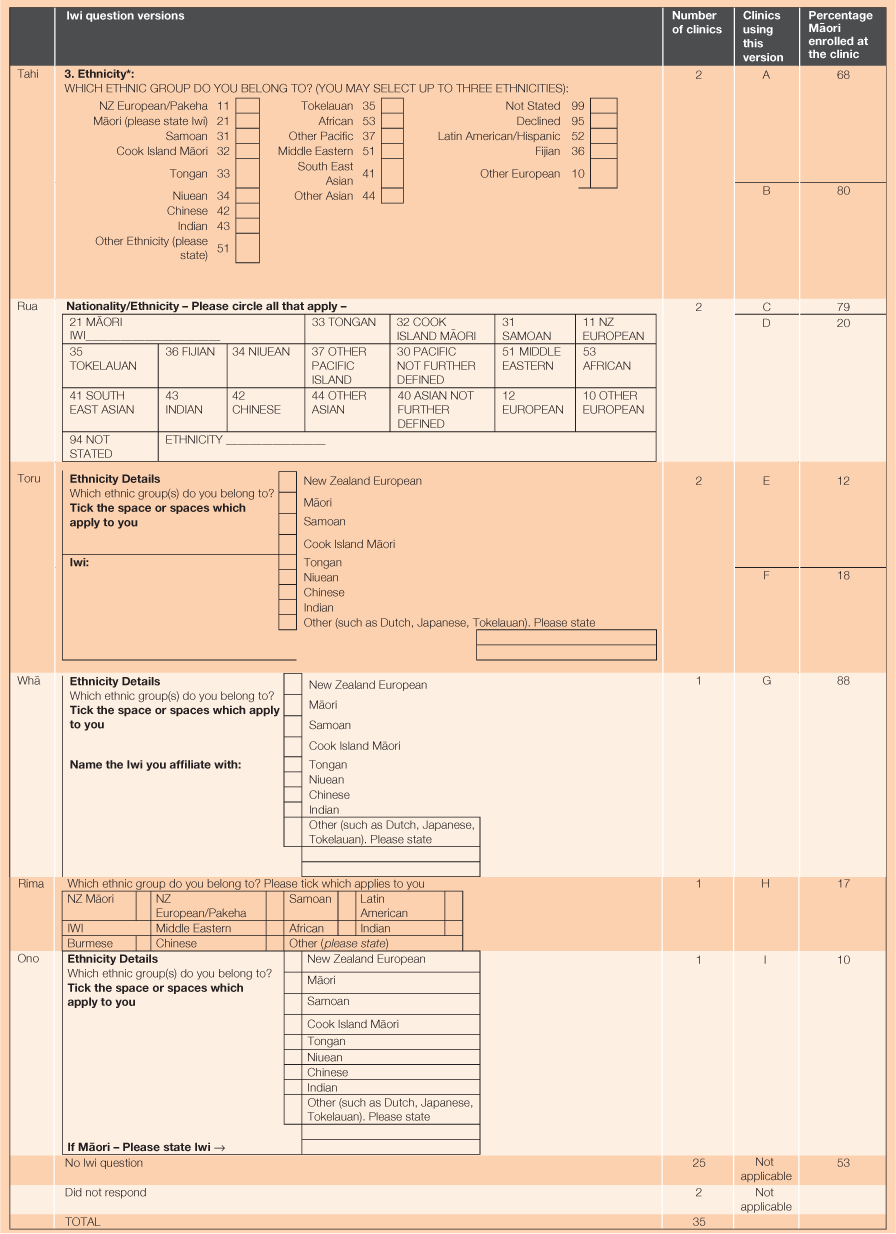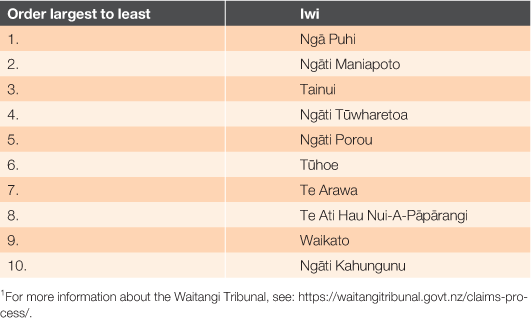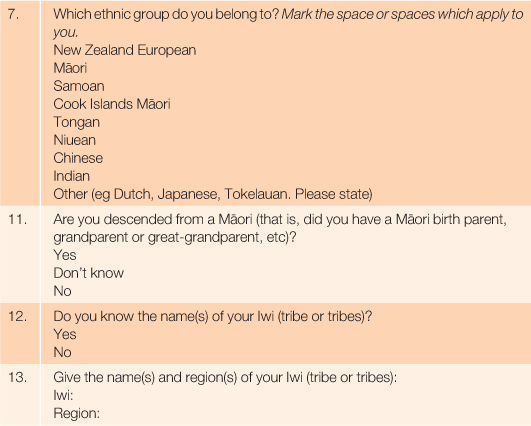Iwi (tribal) data collection at a primary health care organisation in Aotearoa
James (Hemi) Enright 1 , Anneka Anderson 2 , Rawiri McKree Jansen 3 , Jonathan Murray 4 , Karen Brewer 5 , Vanessa Selak 6 , Matire Harwood 7 81 Whangarei Hospital, Northland District Health Board, New Zealand
2 Te Kupenga Hauora Māori, FMHS, University of Auckland, New Zealand
3 Clinical Director, National Hauora Coalition PHO, New Zealand
4 Primary Health Networks, National Hauora Coalition PHO, Auckland, New Zealand
5 Psychology (Speech Science), Faculty of Science, University of Auckland, New Zealand
6 School of Population Health, FMHS, University of Auckland, New Zealand
7 Department of General Practice and Primary Care, Grafton, FMHS, University of Auckland, New Zealand
8 Corresponding author. Email: m.harwood@auckland.ac.nz
Journal of Primary Health Care 13(1) 36-43 https://doi.org/10.1071/HC20037
Published: 15 March 2021
Journal Compilation © Royal New Zealand College of General Practitioners 2021 This is an open access article licensed under a Creative Commons Attribution-NonCommercial-NoDerivatives 4.0 International License
Abstract
INTRODUCTION: Indigenous peoples’ rights include the right to self-determine one’s identity. For Māori, this includes self-assignment of ethnicity, and traditional identities such as Iwi (tribe). New Zealand’s Ministry of Health requires health services to collect ethnicity data using standard protocols. Iwi data are also collected by some health services; however, with no health-specific protocols, little is known about Iwi data collection and quality. The National Hauora Coalition (NHC) Primary Healthcare Organisation (PHO) sought to understand Iwi data collection across its network of primary care providers.
AIM: To understand Iwi data collection at the NHC PHO; specifically, is it being routinely collected, how is it being collected and what are the results?
METHODS: In 2017, NHC’s general practice clinics were invited to submit their enrolment forms, which capture ethnicity and potentially Iwi information, by e-mail to the audit team. Forms were reviewed to determine whether Iwi information was being collected and if so, what question was being used. Iwi numbers were collated from the annual data extract.
RESULTS: Thirty-three of a total of 35 clinics (94%) submitted their enrolment forms to the audit team. Nine of the 33 clinics (27%) sought Iwi name/s with a specific question on their enrolment form. Six different ‘Iwi’ questions were used by the nine clinics. The data extract revealed that the NHC had Iwi data for 13% (2672/20,814) of its Māori enrolments. Ngāpuhi were the largest Iwi group at the NHC.
DISCUSSION: This is the first study to describe the quantity and quality of Iwi data collection in NZ primary care. Standard procedures for collecting, recording and using Iwi data are being developed by the NHC PHO. These could inform national protocols to optimise the quality of Iwi data.
KEYwords: Iwi; Indigenous health data; Primary care; Indigenous data sovereignty; Indigenous identification
| WHAT GAP THIS FILLS |
| What is already known: Health services in Aotearoa are required to collect ethnicity data using standard protocols. Some health services also collect Iwi data, but with no health-specific protocols. Little is known about Iwi data collection and quality. |
| What this study adds: This is the first study to describe the quantity and quality of Iwi data collection in NZ primary care. |
Introduction
There are over 300 million Indigenous Peoples living across the world. Indigenous Peoples are custodians, guardians and practitioners of unique ways of life.1 Many also experience a shared history of colonisation and violation of human rights. For example, some colonial governments did not even acknowledge Indigenous Peoples as human until recently,2 a clear example of institutionalised racism.3
The Declaration on the Rights of Indigenous Peoples4 recognises the right of Indigenous Peoples:
‘to determine their own identity or membership in accordance with their customs and traditions. This does not impair the right of indigenous individuals to obtain citizenship of the States in which they live.’ [Article 33.1]
Self-determined identity as an Indigenous person within a colonised society is an important political statement. It also supports the monitoring of colonising governments and their responsiveness to Indigenous Peoples’ rights.5
In Aotearoa Māori, the Indigenous Peoples, are ‘counted’ as a separate ethnic grouping. Ethnicity in this regard is:
‘the ethnic groups that people identify with or feel they belong to. Ethnicity is a measure of cultural affiliation. It is not a measure of race, ancestry, nationality, or citizenship. Ethnicity is self-perceived and people can belong to more than one ethnic group.’6
It is worth reiterating that ethnicity is as much an individual’s right to self-identify as it is a measure of external assignment and categorization.7
Demographic data, including self-identified ethnicity and Māori descent (ie ancestry, or whakapapa), are collected every 5 years during Aotearoa’s national census. Questions for each are set by NZ Statistics (Figure 1) and these are considered ‘best-practice’. In the 2018 NZ census, 16.5% (775,836) of the total population self-identified as Māori ethnicity8, up from 14.9% in 2013, and this proportion is expected to continue to grow.8 The 2018 population of Māori descent was 19.1% (896,567) of the total usually resident population9, indicating that more Māori claim Māori whakapapa/descent than self-identify as Māori ethnicity.
Ethnicity is just one form of identity available to Māori; Māori identity is also shaped by whakapapa (ancestry/descent) and self-groupings into Iwi (tribes), Hapū (sub-tribe) and whānau (extended family), which are based on whakapapa kinship.11 Iwi are defined by geographical areas and there are over 100 different Iwi across Aotearoa based on the Iwi Statistical Standard, a list of all known Iwi at a specific time.12,13 The list will develop over time with further input from Iwi.14 Table 1 presents the nine largest Iwi reported in the 2013 census (noting that there were issues with Iwi data in the 2018 census15). Some Māori belong to more than one Iwi,16 and this number will increase with inter-marriage and improved access to knowledge of one’s whakapapa.

|
As highlighted in Table 1, not all people identify with or know their Iwi. As a result, many Iwi, Hapū and Whānau are self-funding surveys and census-type activities to identify their own peoples. One example is Ngāi Tahu.17 These Iwi-led activities are particularly important in light of Waitangi Tribunal1 claims so that people who identify with a particular Iwi can participate in decision-making, engage with Iwi-led programs and access support such as scholarships for higher education. Differences in the definitions and methods used to collect Iwi data exist between Statistics NZ and Iwi, as well as between Iwi, which has both strengths (such as Iwi-determination) and limitations (in terms of standardisation).
One potential site for Iwi data collection is health services. Ethnicity data are currently routinely collected by health and disability services in Aotearoa. The Ethnicity Data Protocols, describing the standard procedures for collecting, recording and using data on the ethnicity of people by health services, were updated in 2017.18,19 Although the collection of ethnicity data is mandatory for health services, the Ministry of Health does not require the collection of Iwi data. Instead, it recommends that ‘an iwi response to the ethnicity question is coded to Māori’.18 However, many health services have recorded Iwi names in the person’s patient management system (PMS), although there is little information about the collection methods (including their consistency) or numbers.
The National Hauora Coalition (NHC) Primary Health Organisation (PHO) is a Kaupapa Māori health organisation that, in 2017, had more than 35 general practice clinics across its Auckland and Waikato networks. The PHO had protocols to standardise the collection of most demographic information, including ethnicity; however, it did not have a protocol to collect Iwi information. With an interest in Indigenous data and its use in practice, we sought to better understand Iwi data in our organisation; specifically, is it being routinely collected, how is it being collected and what are the numbers? This project sought to address these questions with an audit of current practice across the NHC general practice clinics in 2017.
Methods
The audit was undertaken over 4 weeks from 14 September to 12 October 2017.
An email explaining the purpose of the audit and requesting the clinic’s current Ethnicity Data Form was sent to the practice managers of NHC’s 35 general practice clinics from the Lead for Network Relations Primary Care Networks. The subject heading was ‘Enrolment Form – Section Ethnicity Iwi’. The email stated ‘We are doing a stock take of all our practices’ enrolment forms who are collecting Iwi in their ethnicity section – would you please send me a copy of your current enrolment form. I understand you are very busy but we would greatly appreciate your help. Thank you in advance – please don’t hesitate to contact me if you have any questions’ and provided the contact details for the Lead Researcher. Practice Managers scanned the forms and sent these by email to the Lead Researcher. When there had been no response within 2 weeks, a follow-up phone call to practice managers was made.
The forms were reviewed for an Iwi-specific question by the audit team of JE, MH and RJ. The audit was supplemented by an extract from each practice of the most recent ethnicity data for their enrolled patients, including Iwi where this was collected. The extract was collated by the NHC for reporting purposes at the end of the fourth quarter of the 2016–17 financial year, which was 30 June 2017.
The project did not require ethical approval as it was an audit, was undertaken by the PHO, and no personal health information was collected.20
Results
Of the 35 NHC clinics at the time of the audit, 33 (94.3%) responded to the audit during the audit period.
Nine (27%) of the 33 responding clinics collected Iwi data on their enrolment forms. These forms are completed in a handwritten format, generally at the time a person enrols in a clinic. As shown in Table 2, there was variation between the nine clinics in the Iwi data question used, its location on the clinic enrolment form, and the space available to write the names of Iwi (up to four). Version Tahi was used by two practices and therefore made available to 13% of the PHO’s Māori enrolments compared to version Rua, used by two practices and available to 17%, and version Toru, used by two practices and available to 9% of Māori. Versions Toru and Whā were the only forms to have room to write the names of up to four Iwi.

|
Most clinics surveyed (24, 73%) did not collect Iwi data. As a result, 11,054 Māori people, or 53% of the total Māori population at the NHC PHO, were not able to document their Iwi in their primary care record.
A review of Iwi data across NHC’s enrolled population revealed further information. At the time of the audit, the NHC had Iwi data for 2672 of the 20,814 (13%) Māori people enrolled. In the auditing process, we found that only one Iwi could be recorded in the electronic Patient Management System (PMS) per person. When questioned about which Iwi was recorded, for people with two or more Iwi listed, administrators advised us that the first on the list was selected. The 10 top Iwi recorded are listed in Table 3. In total, 100 Iwi were recorded.

|
Importantly, 91 people who did not self-identify as Māori ethnicity had an Iwi recorded in their PMS record (Table 2).
Discussion
An audit at the NHC Primary Health Organisation in 2017 was undertaken to understand Iwi data collection at its 35 general practice clinics. Of 33 respondents, nine general practice clinics formally sought the name/s of a person’s Iwi on enrolment forms. There was significant variation with six different ‘Iwi’ questions used by the nine clinics. Data were collected in handwritten format rather than electronically. When available, there was room for the person to write one or up to four Iwi on the different forms. When administrators transferred this information to the person’s electronic patient medical record (PMR), only one Iwi could be listed and administrators chose the first listed. Therefore, Iwi data for some people at NHC practices is not ‘self-determined’. Ngāpuhi were the largest Iwi group. The NHC had Iwi data for 13% of Māori enrolments.
The audit identified several issues. The Iwi data collection questions were not consistent, often did not provide room for more than one name, and were completed at enrolment. Appropriate policy and process at the PHO, including distribution of an exemplar Iwi data collection question as shown in Figure 1,12 in the same way as the PHO provides templates for the collection of ethnicity and other data, would support a standardised approach. In addition, we recommend regular opportunities for people to self-define themselves based on Iwi. Many people find it difficult to integrate both traditional and contemporary identities, thus creating a constant desire for Indigenous Peoples to re-affirm themselves.5 A regular check, in line with current protocols for checking ethnicity and other demographic information every 3 years,18 may help to address this.
At the time of the audit, only one Iwi per person was able to be entered into the PMS record, which is unacceptable. The NHC has taken steps to address this and now all Iwi listed by enrolees are captured in each person’s PMS (pers. comm. with Jonathan Murray, 10 February 2020). Despite the fact that only one Iwi was entered for each person providing their Iwi name/s, the 10 most common Iwi for this PHO were mainly consistent with national data. The main difference was Ngāi Tahu, which did not feature in the top 10 of Iwi at the NHC. This is unsurprising, as NHC practices are located in the North Island, whereas Ngāi Tahu is centred in the South Island. The 91 people with an Iwi recorded, despite not having Māori ethnicity, may reflect an error with data entry or a personal choice to assign non-Māori ethnicity despite being of Māori descent.
Issues with Māori and Iwi data collection and use are well documented,21 with calls for Māori data sovereignty, including complete control over the collection, analysis, storage and use of Māori data.21 Given its infancy, Iwi data collection in primary care could start with setting safe and sustainable rules and processes based on Indigenous Data Sovereignty recommendations.21 Snipp’s22 tenents of data de-colonisation (that Indigenous Peoples exercise sovereignty and control of data, the data reflects the interests and priorities of Indigenous communities and they dictate the content of and access to data) provide an excellent foundation for such rules and processes. Further thought to the governance and operationalisation of the collection, analysis, and dissemination of Iwi data into primary care is recommended.
Iwi and primary care services in Aotearoa may wish to look to international models. For example, in the United States, many health services are run by Tribal entities that collect and analyse data by Tribes who have set their own demographic data agendas.23 The Ysleta del Sur Pueblo (YDSP) and Cheyenne River Sioux (CRS) Tribal peoples in North America are considered the exemplars of providing leadership in this regard.24 Primary care services in Aotearoa could similarly support Iwi in their desire to set and govern their own data programs.25
Most NHC clinics did not collect Iwi data. Iwi data have the potential to provide a level of granularity to Māori data, and supports the rights of people to name themselves in ways that give meaning. It is particularly useful for understanding and tracking outcomes by Iwi, monitoring the responsiveness of health-care services delivered to Iwi, and thereby informing the development of Iwi-specific services.11,26 Other uses include supporting opportunities for people to access Iwi-led health programmes. One example is access to private health insurance for people identifying as Ngāti Whātua Iwi.27 Although such benefits are important, there is a risk that those people who do not have access to whakapapa or knowledge about their Iwi (Table 1) may ‘miss out’. Although not the remit of health-care services, services that safely connect Māori to their Iwi are available28 and could be offered to people.
There are several limitations to this research. It was an audit of a small primary care organisation with 35 general practitioner-led primary care clinics. It is therefore not reflective of all primary care services in NZ. We believe that Iwi-led health services (eg Ngāti Porou Hauora, Ngāti Toa, Ngāti Whātua ki Ōrākei) will have more and better-quality data on Iwi. However, as far we are aware, this is the first Iwi data audit in primary care to be published. Another limitation is that the audit was undertaken at the end of 2017. However, we believe the findings are still relevant today, given the current environment of Iwi development, Waitangi claims and Indigenous data sovereignty.
Despite these limitations, this study makes an important contribution to highlighting systematic problems that contribute to continued restrictions to self-determination of Māori peoples in Aotearoa. The audit revealed areas for improvement at NHC. Plans to implement corrective actions are under way and will be monitored. Standard procedures for collecting, recording and using Iwi data are being developed by the NHC PHO. These could be used as the basis for national protocols to optimise the quality of Iwi data.
Competing interests
AA, RMJ and JM are employees of the NHC PHO. The other authors (KB, JE, MH and VS) have no competing interests to declare.
Acknowledgements
To Marleen Tuigamala, all NHC clinics and the Mōhio team at NHC, ngā mihi for your support during the audit. This audit did not receive any external funding.
References
[1] United Nations. Indigenous Peoples at the United Nations. New York: United Nations; 2017 [cited 20 Feb 2020]. Available from: https://www.un.org/development/desa/indigenouspeoples/about-us.html[2] Attwood B, Marcus A. The 1967 Referendum: race, power and the Australian Constitution. 2nd ed. Canberra: Aboriginal Studies Press, Australian Institute of Aboriginal and Torres Strait Islander Studies; 2007.
[3] Henry BR, Houston S, Mooney GH. Institutional racism in Australian healthcare: a plea for decency. Med J Aust. 2004; 180 517–20.
| Institutional racism in Australian healthcare: a plea for decency.Crossref | GoogleScholarGoogle Scholar | 15139829PubMed |
[4] United Nations. United Nations Declaration on the Rights of Indigenous Peoples. New York: United Nations; 2007.
[5] Gagné N. Maori identities and visions: politics of everyday life in Auckland, New Zealand. Montreal: McGill University; 2004.
[6] Statistics New Zealand. Ethnicity 2020. Available from: https://www.stats.govt.nz/topics/ethnicity
[7] Jenkins R. Rethinking ethnicity. London: Sage; 2008.
[8] Statistics New Zealand. New Zealand’s Population reflects growing diversity. 2019. [cited 27 March 2020]. Available from: https://www.stats.govt.nz/news/new-zealands-population-reflects-growing-diversity
[9] Statistics New Zealand. Deriving the 2018 Māori descent electoral population. 2019. [cited 5 April 2020]. Available from: https://www.stats.govt.nz/methods/deriving-the-2018-maori-descent-electoral-populaton
[10] Statistics New Zealand. New Zealand Census of Population and Dwellings. Individual form Tuesday 6 March 2018 [Internet]. Statistics New Zealand; 2018. Available from: https://cdm20045.contentdm.oclc.org/digital/collection/p20045coll2/id/713/rec/3
[11] Kukutai T. The problem of defining an ethnic group for public policy: who is Maori and why does it matter. Soc Policy J N Z. 2004; 23 86–108.
[12] Kōkiri TP. Te Kāhui Māngai (Directory of Iwi and Māori Organisations). 2017. [cited 2020 April 5]. Available from: http://www.tkm.govt.nz/
[13] Statistics New Zealand. Iwi statistical standard: September. 2017. [cited 2020 April 13]. Available from: http://archive.stats.govt.nz/methods/classifications-and-standards/current-classifications-and-standards-review/final-iwi-std-2017-review/final-iwi-standard-2017.aspx
[14] Statistics New Zealand. Iwi and iwi-related groups. 2017. [cited 2020 April 5]. Available from: http://aria.stats.govt.nz/aria/?_ga=2.34191009.1057678527.1586039963-883020159.1576699106#ConceptView:uri=http://stats.govt.nz/cms/Concept/K54WB027ut0v57PH
[15] Kukutai T, Cormack D. Census 2018 and Implications for Māori. N Z Popul Rev. 2018; 44 131–51.
[16] Statistics New Zealand. 2013 Census QuickStats about Māori [Internet]. Statistics New Zealand; 2013. Available from: http://archive.stats.govt.nz/Census/2013-census/profile-and-summary-reports/quickstats-about-maori-english/population.aspx
[17] Te Rūnanga o Ngāi Tahu. State of the Nation. Christchurch: Te Rūnanga o Ngāi Tahu; 2016.
[18] Ministry of Health. HISO 10001:2017 Ethnicity Data Protocols [Internet]. Wellington: Ministry of Health; 2017. Available from: https://www.health.govt.nz/publication/hiso-100012017-ethnicity-data-protocols
[19] Statistics New Zealand. Purpose of the Iwi Statistical Standard and Classification. 2018. [cited 2020 March 27]. Available from: https://www.stats.govt.nz/methods/purpose-of-the-iwi-statistical-standard-and-classification
[20] Health and Disability Ethics Committees. Find out if your study requires HDEC review. 2020. [cited 2020 March 10]. Available from: https://ethics.health.govt.nz/hdec-review-and-approvals/find-out-if-your-study-requires-hdec-review
[21] Te Mana Raraunga Māori Data Sovereignty Network. Our Data, Our Sovereignty, Our Future. 2017. [cited 2020 April 5]. Available from: https://www.temanararaunga.maori.nz/
[22] Snipp CM. What does data sovereignty imply: what does it look like? In: Kukutai T, Taylor J, editors. Indigenous Data Sovereignty: Towards an agenda. Canberra: Australian National University Press; 2016. pp. 39–51.
[23] Rodriguez-Lonebear DJIdsTaa. Building a data revolution in Indian country. In: Indigenous Data Sovereignty: Toward an Agenda, T. Kukutai and J. Taylor, editors. Australia: Australian National University Press. 2016: 253–72.
[24] Rainie SC, Schultz JL, Briggs E, Riggs P, Palmanteer-Holder NL. Data as a strategic resource: self-determination, governance, and the data challenge for Indigenous nations in the United States. Intl Indigenous Policy J. 2017; 8
[25] Gifford H, Mikaere K. Te Kete Tū Ātea: towards claiming Rangitīkei iwi data sovereignty. J Indig Wellbeing. 2019; 4 6–14.
[26] Nikora LW. Race, culture and ethnicity: organisation of Maori social groups. Hamilton; 1995.
[27] Nei MEN, Roars TN. Ngāti Whātua Ōrakei Health Insurance, The descendents of Tuperiri stand. Auckland; 2018.
[28] Tūhono. Tūhono. Hamilton. [cited 2020 April 14]. Available from: https://www.tuhono.net/



